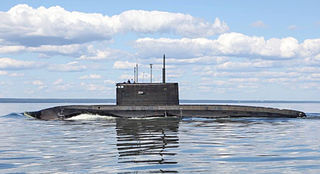
The Kilo-class submarines are a group of diesel-electric attack submarines designed by the Rubin Design Bureau in the Soviet Union in the 1970s and built originally for the Soviet Navy.
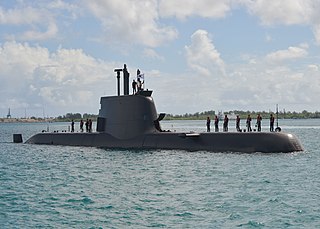
The Type 214 is a class of diesel–electric submarines developed exclusively for export by Howaldtswerke-Deutsche Werft GmbH (HDW). It features diesel propulsion with an air-independent propulsion (AIP) system using Siemens polymer electrolyte membrane (PEM) hydrogen fuel cells. The class combines the design principles of the Type 209 submarine family and the features of the Type 212A submarine. However, as an export design, it lacks some of the classified technologies of the Type 212 such as the non-magnetic steel hull that makes it difficult to detect using a magnetic anomaly detector.

Sindhughosh-class submarines are Kilo-class diesel-electric submarines in active service with the Indian Navy. Their names are in Sanskrit, but in their Roman-alphabet forms sometimes a final short -a is dropped.

The Scorpène-class submarines are a class of diesel-electric attack submarines jointly developed by the French Naval Group and the Spanish company Navantia. It features diesel propulsion and an additional air-independent propulsion (AIP). It is now marketed as the Scorpène 2000.
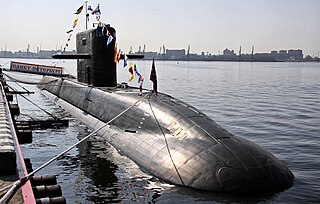
Lada class, Russian designation Project 677 Lada is the new advanced class of diesel-electric attack submarine designed by the Russian Rubin Design Bureau. A program to develop a "fourth generation" diesel-electric submarine, it aimed to produce a highly improved version of the Project 636 with better acoustic signature, new combat systems and possibly air-independent propulsion. However, in 2019, Alexander Buzakov, the head of the Admiralty Shipyard, indicated that there were no plans to equip the Lada class with an air-independent propulsion system. In July 2022 it was reported that work on an electrochemical generator to produce hydrogen from diesel fuel and oxygen was continuing and that the Rubin Central Design Bureau signed a new contract in 2019 to continue work. This was scheduled to be completed by the mid-2020s. In 2023, the decision was taken to decommission and scrap the lead ship of the class, the Sankt Peterburg due to the very high costs of modernising the submarine.

Garden Reach Shipbuilders & Engineers Ltd, abbreviated as GRSE, is one of India's leading shipyards, located in Kolkata. It builds and repairs commercial and naval vessels. GRSE also exports the ships that the company builds.
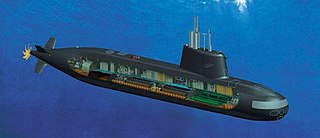
The S1000-class submarine was a joint development by Russia and Italy, said to be an advanced version of the Amur-class submarine. The joint development was between Rubin Design Bureau of Russia and Fincantieri of Italy. The project was suspended in 2014.

The Kamorta-class corvettes or Project 28 are a class of anti-submarine warfare corvettes currently in service with the Indian Navy. Built at Garden Reach Shipbuilders & Engineers (GRSE), Kolkata, they are the first anti-submarine warfare stealth corvettes to be built in India. Project 28 was approved in 2003, with construction of the lead ship, INS Kamorta commencing on 12 August 2005. All of the four corvettes, INS Kamorta, INS Kadmatt, INS Kiltan and INS Kavaratti were commissioned in 2014, 2016, 2017 and 2020 respectively.

INS Sindhughosh (S55) is the lead ship of her class of diesel-electric submarines of the Indian Navy.

JSC PO Sevmash is a Russian joint-stock company (JSC) under the vertically-integrated United Shipbuilding Corporation. The shipbuilding operations of Sevmash is in the port city of Severodvinsk on the White Sea in the Russian Federation.
INS Sindhudhvaj (S56) was a Sindhughosh-class submarine of the Indian Navy in service from 1987 until 16 July 2022, when she was decommissioned.
INS Sindhuraj (S57) is a Sindhughosh-class diesel-electric submarine of the Indian Navy.
UMS Minye Theinkhathu (71) is a Sindhughosh (Kilo)-class submarine owned by the Myanmar Navy. It is the first of two submarines procured by the country's navy, followed by the UMS Minye Kyaw Htin. Before being acquired by Myanmar, it served in the Indian Navy as INS Sindhuvir (S58).
INS Sindhuratna (S59) is a Sindhughosh-class diesel-electric submarine of the Indian Navy.
INS Sindhukesari (S60) is a Sindhughosh-class diesel-electric submarine of the Indian Navy.

INS Sindhukirti (S61) is the seventhSindhughosh-class diesel-electric submarine of the Indian Navy. She was built at the Admiralty Shipyard and Sevmash in the Soviet Union.
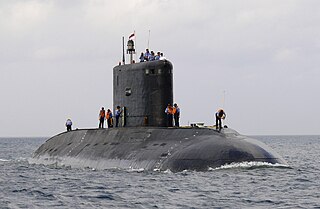
INS Sindhuvijay (S62) is a Sindhughosh-class diesel-electric submarine of the Indian Navy.
Following the dissolution of the Soviet Union at the end of 1991, the Russian Navy struggled to adjust Cold War force structures while suffering severely with insufficient maintenance and a lack of funding. However, there were improvements in the Russian economy over the first decade of the twenty-first century. The economy and standard of living grew rapidly during the early period of Putin's regime, fueled largely by a boom in the oil industry. This led to a significant rise in defence expenditure and an increase in the number of ships under construction.

Project-75 (India), simply referred to as the P-75(I) program, is a military acquisition initiative affiliated to India's Ministry of Defence (MoD), aimed at the planned procurement of diesel-electric submarines for the Indian Navy (IN). Originally conceived in 1997, the initiative's objective has been to procure a class of six conventionally-powered attack submarines for the Indian Navy Submarine Arm, as a replacement for the force's Sindhughosh-class submarines.

INS Vela (S24) is the fourth submarine of the first batch of six Kalvari-class submarines for the Indian Navy. It is a diesel-electric attack submarine based on the Scorpène class, designed by French naval defence and energy group DCNS and manufactured by Mazagon Dock Limited, an Indian shipyard in Mumbai. The first cutting of steel for the submarine began on 14 July 2009, and the ship was launched on 6 May 2019.













